Comments
- No comments found

How did the pandemic affect the economic side of global connectedness?
International travel went way down in 2020, as one would expect. But other aspects of connectedness–flows of trade, capital, and especially information–held up pretty well in the first year of the pandemic. Steven A. Altman and Caroline R. Bastian tell the story with figures and short descriptions in DHL Global Connectedness Index 2021 Update: Globalization Shock and Recovery in the Covid-19 Crisis (November 2021).
For example, here’s a pattern of merchandise and services trade around the world. Merchandise trade peaked in 2008, and the drop in 2020 was modest. The authors report that trade in goods in 2021 has now risen above pre-pandemic levels. Services trade has generally been rising, and it drops more substantially in 2020, but much of that decline is due to the fall of nearly three-quarters in international travel.
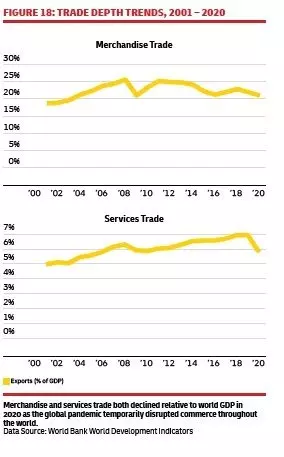
Another interesting pattern is that the distance that exports travelled has been rising over time, and kept rising in 2020. One possible interpretation here is that the pandemic had a bigger effect on limiting short-distance international trade (say, trucks crossing borders), rather than long-distance international trade (say, container ships).
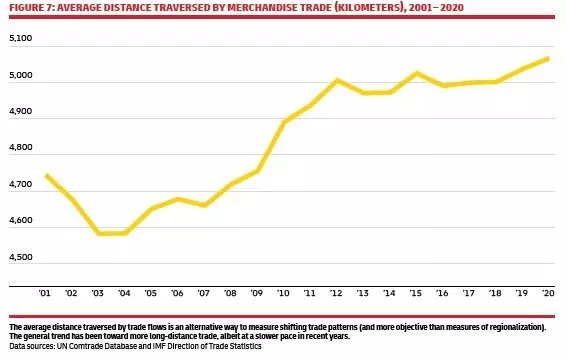
In the areas of international capital flows, the authors write: “The pandemic dealt a major blow to international capital flows, but portfolio equity flows stabilized in mid-2020 and foreign direct investment began a strong rebound in 2021.”
Flows of international travelers (per capita) dropped off, as shown in the first panel. However, the second panel shows that the share of students coming across borders rose in 2020, and the third panel shows that international migrants rose in 2020, too.
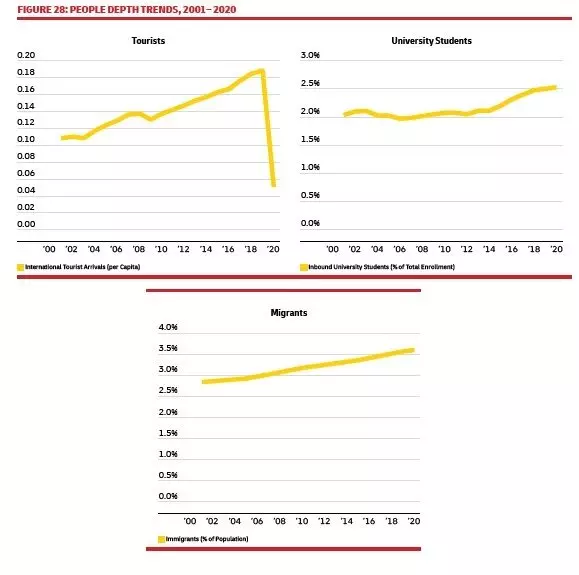
International information flows kept rising. International internet traffic had been growing about 20-25% per year before the pandemic. That growth rate spiked to almost 50% in 2020, but then has fallen back into the usual range in 2021. The left-hand figure shows that the share of all phone calls that are international keeps rising; the right-hand paper shows that the share of scientific publications co-authors by teams from different countries keeps rising, too.
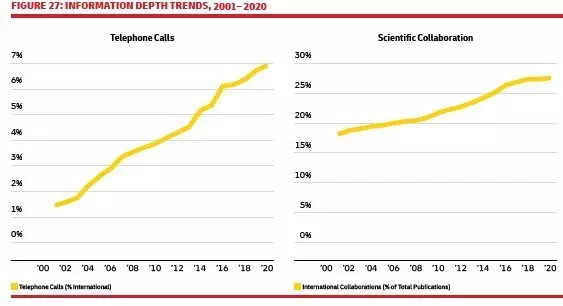
One section of the report looks at trade ties between the US and China. After the trade war that kicked off in 2018 and the pandemic, one might expect trade between the world’s two biggest economies to have fallen, but the pattern is more one of continuity than of change. For example, the left-hand panels show China-US trade as a share of China’s GDP (top) and a share of China’s trade with all countries (bottom). China’s overall exports soared in the early 2000s, after China joined the World Trade Organization in 2001 The bottom left panel shows that the share of China’s exports to the US as opposed to other countries didn’t rise much at that time–China’s exports soared everywhere. As a share of China’s GDP, exports to the US spiked in the early 2000s, but then dropped back to previous levels and have been sagging since about 2010. You can see the downward bump of the 2018 trade war in these figures, but US-China trade generally recovered back to earlier levels in 2020.
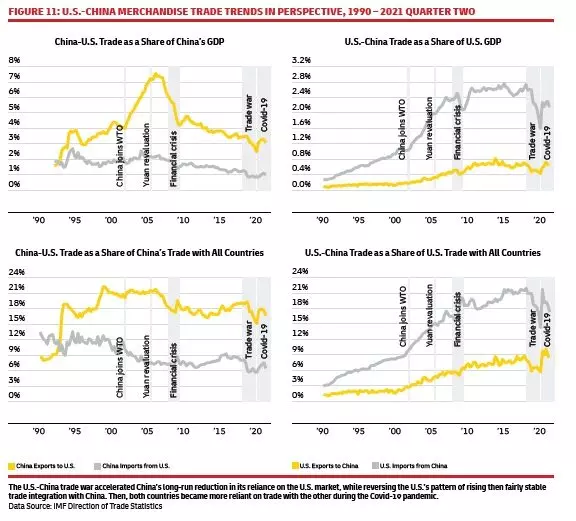
One doesn’t want to over-interpret data from any single year, of course, much less a pandemic year. But it feels as if the nature of globalization, broadly understood, is evolving from goods to services, and from finances to information flows. If someone asks about your views of globalization, it’s reasonable to being by sorting out the different categories.
Timothy Taylor is an American economist. He is managing editor of the Journal of Economic Perspectives, a quarterly academic journal produced at Macalester College and published by the American Economic Association. Taylor received his Bachelor of Arts degree from Haverford College and a master's degree in economics from Stanford University. At Stanford, he was winner of the award for excellent teaching in a large class (more than 30 students) given by the Associated Students of Stanford University. At Minnesota, he was named a Distinguished Lecturer by the Department of Economics and voted Teacher of the Year by the master's degree students at the Hubert H. Humphrey Institute of Public Affairs. Taylor has been a guest speaker for groups of teachers of high school economics, visiting diplomats from eastern Europe, talk-radio shows, and community groups. From 1989 to 1997, Professor Taylor wrote an economics opinion column for the San Jose Mercury-News. He has published multiple lectures on economics through The Teaching Company. With Rudolph Penner and Isabel Sawhill, he is co-author of Updating America's Social Contract (2000), whose first chapter provided an early radical centrist perspective, "An Agenda for the Radical Middle". Taylor is also the author of The Instant Economist: Everything You Need to Know About How the Economy Works, published by the Penguin Group in 2012. The fourth edition of Taylor's Principles of Economics textbook was published by Textbook Media in 2017.
Leave your comments
Post comment as a guest